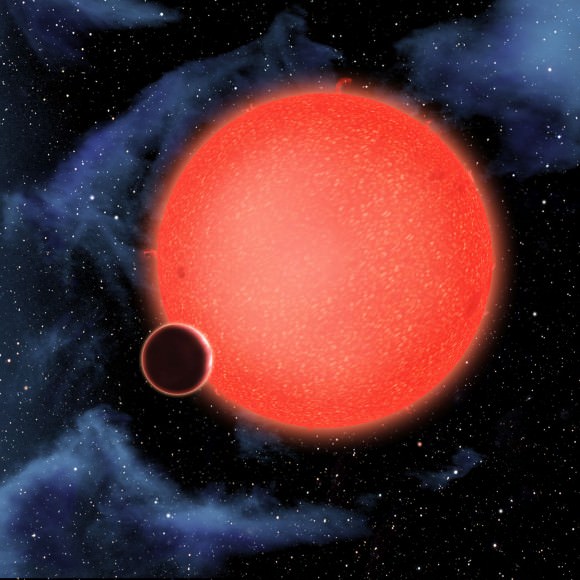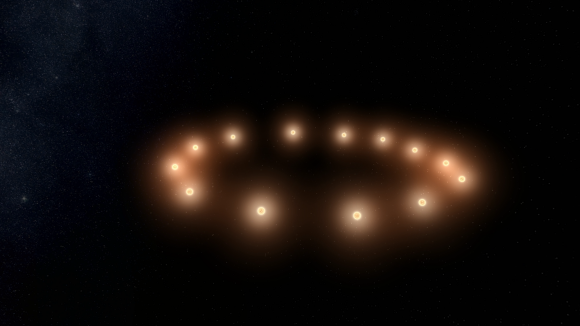Posted on 09/25/2016 6:21:25 PM PDT by LibWhacker
Remember the movie Sunshine, where astronomers learn that the Sun is dying? So a plucky team of astronauts take a nuclear bomb to the Sun, and try to jump-start it with a massive explosion. Yeah, there’s so much wrong in that movie that I don’t know where to start. So I just won’t.
Seriously, a nuclear bomb to cure a dying Sun?
Here’s the thing, the Sun is actually dying. It’s just that it’s going to take about another 5 billion years to run of fuel in its core. And when it does, Cillian Murphy won’t be able to restart it with a big nuke.
But the Sun doesn’t have to die so soon. It’s made of the same hydrogen and helium as the much less massive red dwarf stars. And these stars are expected to last for hundreds of billions and even trillions of years.
Is there anything we can do to save the Sun, or jump-start it when it runs out of fuel in the core?
First, let me explain the problem. The Sun is a main sequence star, and it measures 1.4 million kilometers across. Like ogres and onions, the Sun is made of layers.

The interior structure of the Sun. Credit: Wikipedia Commons/kelvinsong
The innermost layer is the core. That’s the region where the temperature and pressure is so great that atoms of hydrogen are mashed together so tightly they can fuse into helium. This fusion reaction is exothermic, which means that it gives off more energy than it consumes.
The excess energy is released as gamma radiation, which then makes its way through the star and out into space. The radiation pushes outward, and counteracts the inward force of gravity pulling it together. This balance creates the Sun we know and love.
Outside the core, temperatures and pressures drop to the point that fusion can no longer happen. This next region is known as the radiative zone. It’s plenty hot, and the photons of gamma radiation generated in the core of the Sun need to bounce randomly from atom to atom, maybe for hundreds of thousands of years to finally escape. But it’s not hot enough for fusion to happen.
Outside the radiative zone is the convective zone. This is where the material in the Sun is finally cool enough that it can move around like a lava lamp. Hot blobs of plasma pick up enormous heat from the radiative zone, float up to the surface of the Sun, release their heat and then sink down again.
The only fuel the Sun can use for fusion is in the core, which accounts for only 0.8% of the Sun’s volume and 34% of its mass. When it uses up that hydrogen in the core, it’ll blow off its outer layers into space and then shrink down into a white dwarf.
The radiative zone acts like a wall, preventing the mixing convective zone from reaching the solar core.
If the Sun was all convective zone, then this wouldn’t be a problem, it would be able to go on mixing its fuel, using up all its hydrogen instead of this smaller fraction. If the Sun was more like a red dwarf, it could last much longer.

Red dwarf stars burn for much longer than our Sun. Credit: NASA, ESA, and D. Aguilar (Harvard-Smithsonian Center for Astrophysics)
In order to save the Sun, to help it last longer than the 5 billion years it has remaining, we would need some way to stir up the Sun with a gigantic mixing spoon. To get that unburned hydrogen from the radiative and convective zones down into the core.
One idea is that you could crash another star into the Sun. This would deliver fresh fuel, and mix up the Sun’s hydrogen a bit. But it would be a one time thing. You’d need to deliver a steady stream of stars to keep mixing it up. And after a while you would accumulate enough mass to create a supernova. That would be bad.
But another option would be to strip material off the Sun and create red dwarfs. Stars with less than 35% the mass of the Sun are fully convective. Which means that they don’t have a radiative zone. They fully mix all their hydrogen fuel into the core, and can last much longer.
Imagine a future civilization tearing the Sun into 3 separate stars, each of which could then last for hundreds of billions of years, putting out only 1.5% the energy of the Sun. Huddle up for warmth.
But if you want to take this to the extreme, tear the Sun into 13 separate red dwarf stars with only 7.5% the mass of the Sun. These will only put out .015% the light of the Sun, but they’ll sip away at their hydrogen for more than 10 trillion years.

Stick the Earth in the middle and you’d have some very odd sunrises and sunsets, not to mention orbital dynamics. Created with Universe Sandbox ²
But how can you get that hydrogen off the Sun? Lasers, of course. Using a concept known as stellar lifting, you could direct a powerful solar powered laser at a spot on the Sun’s surface. This would heat up the region, and generate a powerful solar wind. The Sun would be blasting its own material into space. Then you could use magnetic fields or gravity to direct the outflows and collect them into other stars. It boggles our imagination, but it would be a routine task for Type III Civilization engineers on star dismantling duty.
So don’t panic that our Sun only has a few billion years of life left. We’ve got options. Mind bendingly complicated, solar system dismantling options. But still… options.
That’s the “alien” craft motive method in The Bowl of Heaven, good two book series by Niven and Benford.

Lacks imagination.
Managing a star is ultimately a matter of being able to introduce material for fusion while removing the products of same. In particular the build up of heavy matter already building up in the core of a star.
This last is absolutely critical because it seems that the formation of iron in a star is its death sentence.
Ordinary matter cannot possibly perform such a function (moving around matter in a star) but it may be possible that plasma constructs can. They would need the ability to maintain their structure and for scifi use I would say the likely route for that is if the constructs introduced stable storms around them, leeching some of the power of the sun’s magnetic system. Then, from that, tendrils of the mechanism would extend downwards.
Each mechanism, in what would amount to controlling the stellar weather, needed would probably be huge (continent sized for any book I was writing ... plus the shielding storms around them) and it would be managed by staff using controlled servo robots, also of plasma, to maintenance and perform all “manual” functions ... their ordinary flesh and blood bodies far from the maelstrom that they are actively managing (Avatar on steroids).
If a civilization can perform such feats they could probably just as easily create new worlds around new stars, maybe even custom made stars.
But if they had built a ring world or Dyson sphere it makes sense to manage their star in this way. With enough stellar gas to harvest or “young” red dwarfs to steal from you could keep such a scheme going for a very long time.
Tax the Internet — Save The Sun!!
It’s global warming/climate change on the sun. Help to prevent it by donating large sums of money to ... me???
Raise taxes.
Leave it to a libtard to think of that.
I have a charitable foundation dedicated to solving the problem, The Solar Depletion Fund. Donations are accepted.
Among issues we are looking at is insulation for Earth, moving Earth, combining Saturn, Neptune, Uranus and Jupiter and igniting fusion there then moving Earth, building a Dyson sphere either here or around an existing red dwarf.
Please donate today, the future of your children and the whales is at stake.
(Disclaimer, the Solar Depletion Fund is owned and operated by DBrow’s Secure carbon Credit Company LLC)
Sounds like quite an undertaking. Expensive. Dangerous. Most of the work would probably have to be done at night.
It’s just that it’s going to take about another 5 billion years to run of fuel in its core.
I’ll be dead by then.
California will pass a law requiring the Sun to stop shining at night.
ping
Yes, this has been the plan all along. A global array of solar collectors designed to not only drain the Sun, but to also charge the nickle core of planet Earth, much like a battery.
Then, with the positive terminal being at the Great Pyramid at Giza and the asteroid at Mecca being negative, we would unleash the global power to change the climate, ha ha.
And it would have worked, except for those meddling kids and that dog!
No, I don't. Probably because the plot is beyond ludicrous...
Vote Trump!

I'll be darned - it's a Wankel.
I’ve been saying for months that Tabby’s star, and another one just like it that they’ve recently discovered, may be caused by primordial mini-black holes orbiting within the star itself, around and perhaps even through, the core — but no one is listening... <**sniff**>.
I mean, it’s conceivable to me that primordial black holes, each with the mass of a small moon, say (this would have to be mathematically worked out), and event horizons on the order of a few inches, could plow through the thin material found in the interior of a star as if it wasn’t there, not sucking in much material at all because their event horizons and masses are too small, and yet be able to thoroughly disrupt fusion in the core.
Migrating to other systems and terraforming other planets sounds relatively easy by comparison.
It was a HORRIBLE movie, not even one star, so to speak.
I learned more about the dynamics of the sun from this article than anything I’d managed peruse accidentally, ever.
Thank you!
Disclaimer: Opinions posted on Free Republic are those of the individual posters and do not necessarily represent the opinion of Free Republic or its management. All materials posted herein are protected by copyright law and the exemption for fair use of copyrighted works.